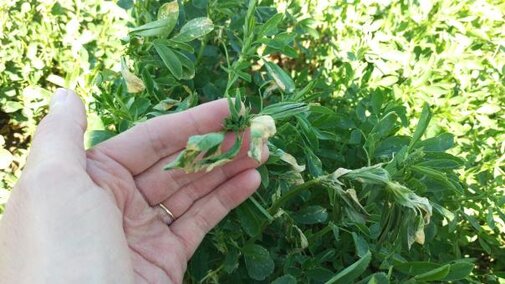Wellhead protection areas of many Nebraska towns have been threatened with high aquifer nitrate levels. Alfalfa in rotation with annual crops has long been recognized as a means to reduce nitrate leaching.
Research has shown that in a 9- or 10-year rotation cycle with five years of corn and soybean rotation and four or five years of alfalfa, mean profit was 9% more with alfalfa in the rotation than with a continuous corn-soybean rotation for owned land. Applied fertilizer-N may be reduced by 66% with alfalfa in the rotation. In addition, alfalfa roots can be expected to deplete soil nitrate to a 10-foot depth (Kranz, et al., 2005).
Alfalfa will use the nitrate applied in irrigation water, reducing nitrate in the aquifer. If an average of 16 inches per year of irrigation water with 15 ppm nitrate-N is applied during a five-year stage of the alfalfa in a 10-year rotation cycle, about 270 lbs/ac of nitrate-N would be removed from the aquifer. If the alfalfa crop reduces soil nitrate-N to a 10-foot depth by an average of 5 ppm, about 240 lbs/ac of nitrate-N would be removed from the soil. Addition of alfalfa to the rotation may be a cost-effective means of reducing aquifer nitrate concentrations.
A spreadsheet calculator was developed to compare the profitability of rotations that include alfalfa with the corn-soybean or corn-soybean-wheat rotations. The rotations compared were:
- Continuous corn-soybean (C:S) rotation;
- Alfalfa (A) summer-sown following oats (O) (10-year rotation of C:S:C:S:O:A:A:A:A:A:C:S:C:S:O:A….);
- Alfalfa (A) spring-sown following corn (9-year rotation of C:S:C:S:C:A:A:A:A:C:S:C:S:C:A….); and,
- Alfalfa (A) spring-sown following corn (10-year rotation of C:S:C:S:C:A:A:A:A:A:C:S:C:S:C:A….).
The calculations were done for irrigated production in Knox County. Assumed yields were:
- 220 bu/ac for corn following soybean;
- 231 bu/ac for corn following alfalfa;
- 60 bu/ac for soybean;
- 3.5 t/ac with late summer sowing and 2.5 t/ac with spring sowing for first year of alfalfa; and
- 6 t/ac for other years of alfalfa.
Grain prices used were: $3.50/bu for corn; $8/bu for soybean; and $125/t for alfalfa hay. Calculations were for rental and for owned land, and for no-till and tilled. Costing was at custom rates for all oat and alfalfa operations and with grower owned equipment for corn and soybean operations.
Rotations with alfalfa had an average of 7% more profit than the corn-soybean rotation. With no consideration of federal farm program disaster payments or crop insurance indemnities.2 The mean net profit was $-24.39/ac for the corn-soybean rotation and $-12.80/ac for rotations with alfalfa for rented land at $250/ac, and $160.61/ac for C:S and $172.20/ac for rotations with alfalfa for owned land. The most profitable rotation was No. 4 (alfalfa (A) spring-sown following corn in a 10-year rotation of C:S:C:S:C:A:A:A:A:A:C:S:C:S:C:A).
In conclusion, there is an opportunity to reduce the loss of nitrate to aquifers and increase the extraction of nitrate from aquifers by including alfalfa in crop rotations while improving profitability.
References
Kranz, W.L., C.A. Shapiro, B.E. Anderson, M.C. Brumm, M. Mamo. Effect of swine lagoon water application rate and alfalfa harvest frequency on dry matter production and N harvest. 2005. Applied Engineering in Agriculture. 22(2):211-216. Depletion of soil nitrate-N with alfalfa was studied at the University of Nebraska-Lincoln Haskell Agricultural Laboratory near Concord.
2Traditional USDA-Farm Service Agency (FSA) farm programs account for historical base acres instead of actual plantings when determining disaster assistance. Incorporating alfalfa in a crop rotation does not limit the ability to participate in federal disaster programs as the payment would be the same regardless of the qualified disaster assistance. Crop insurance indemnities will vary based upon the actual crops planted and change in market prices throughout the growing season. Future indemnities remain hard to predict due to uncertainties in farm-level yields and prices.

